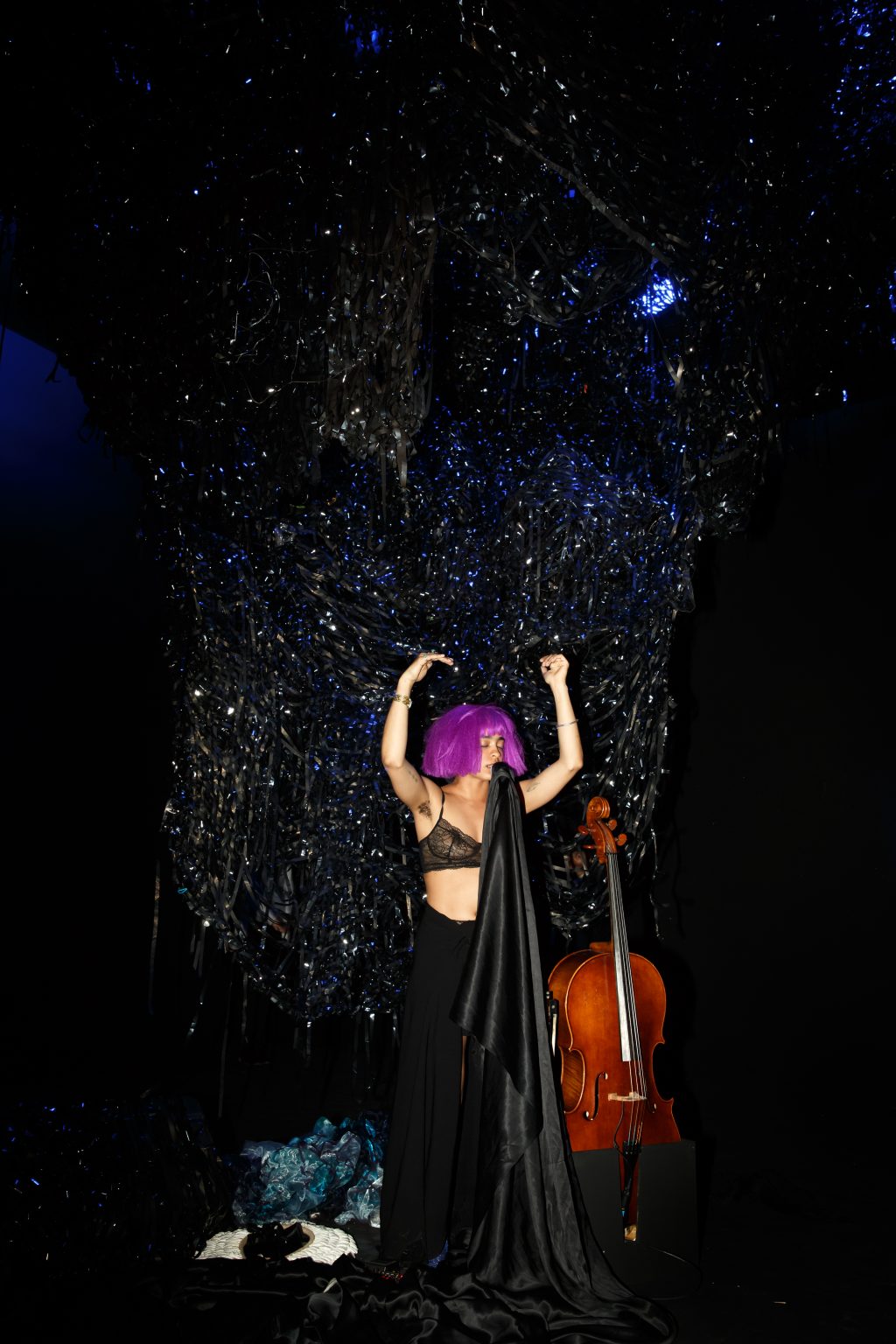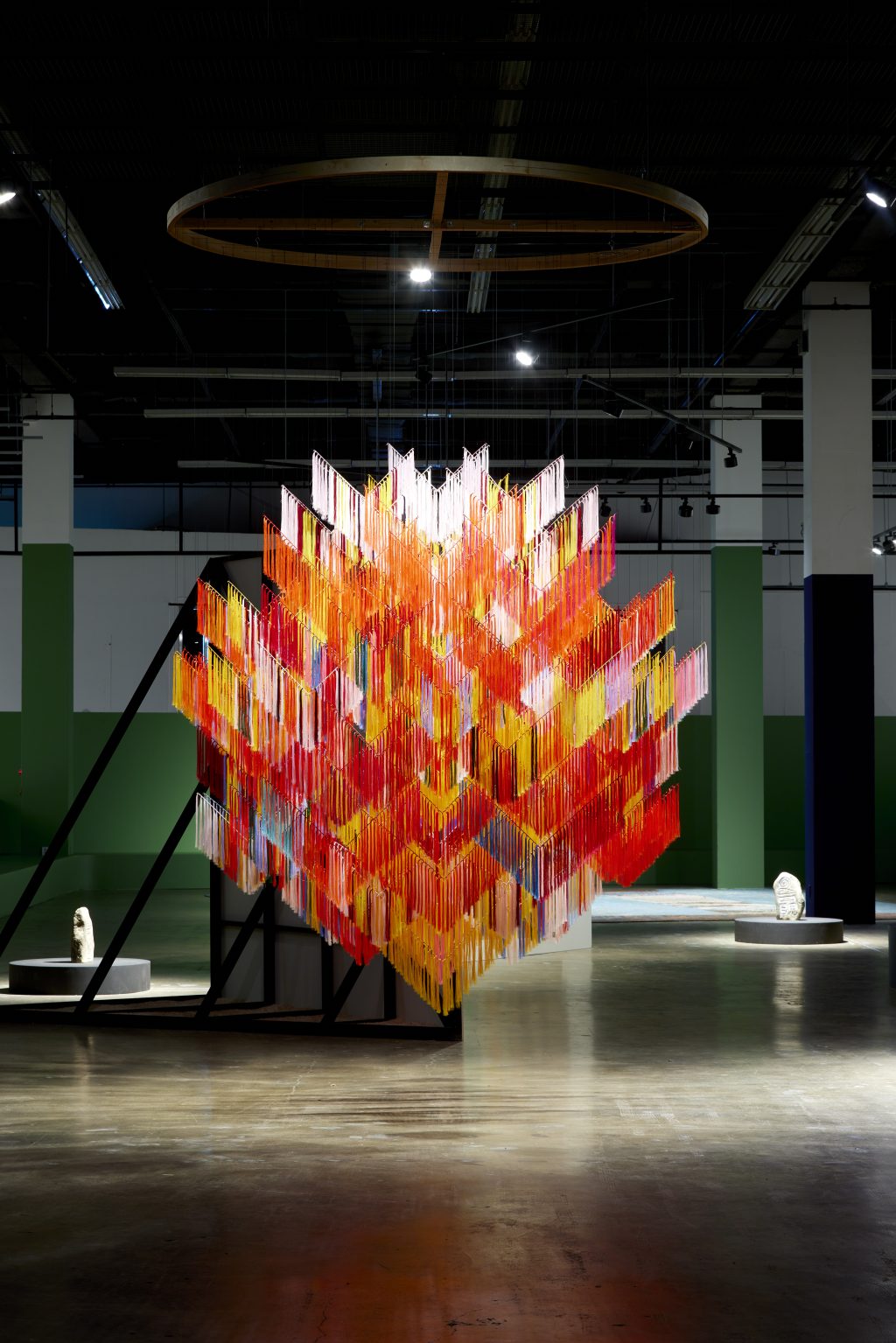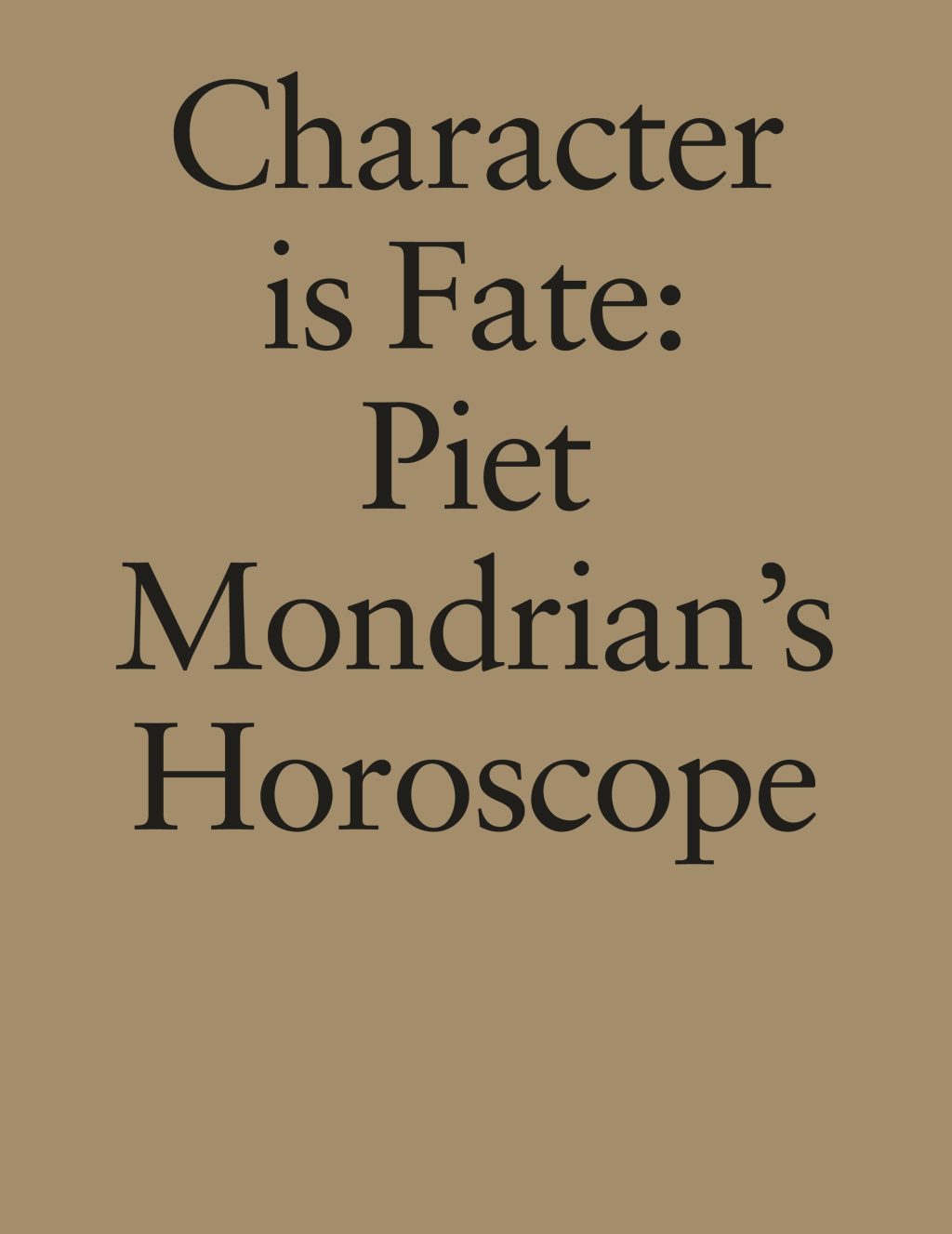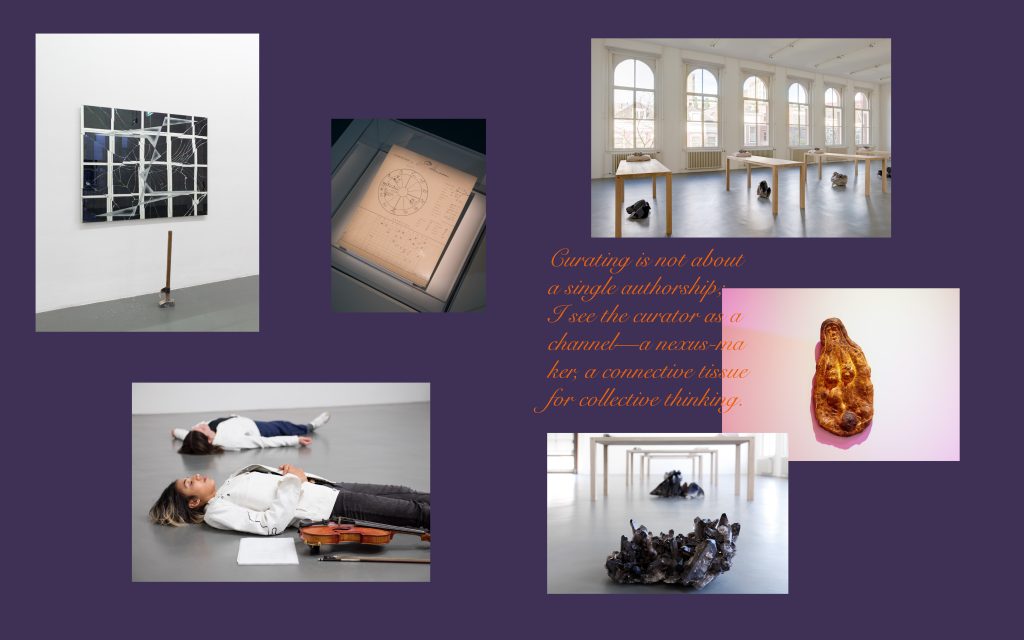Navigating the Interstitial w/ Defne Ayas
Defne Ayas approaches curating as both art and a philosophy, a practice of dismantling outdated structures and reassembling them into dynamic, transformative spaces. Her work transcends conventional boundaries, weaving connections between disparate geographies, histories, and disciplines. Each project becomes an experiment in thought and form, where disruption can give way to creation, and collaboration serves as a vessel for collective possibilities and impact.
In this conversation, Ayas offers a reflection on the forces that have shaped her journey. She explores the interplay between human and systemic change, the evolving roles of institutions, and the possibilities inherent in merging analog and digital realms. Her insights reveal a curatorial practice that resists the static, embracing instead the fluid, the nuanced, and the daringly speculative. This is an encounter with a curator whose vision reframes the act of curation as both an artistic and intellectual pursuit, grounded in the urgent realities of our time yet always reaching for the horizon.
Reflecting on your journey into curating, what experiences or influences have most shaped your curatorial perspective
What are my superpowers, really? My invisibility cloak? My mind-reading skills? My prophetic abilities? Or perhaps a sense of theater, editorial timing, political insight, and a spirit of collaboration that consistently guides me. I’m always drawn to system-hacking—seeking ways to transcend the rituals of attention-grabbing and connect to a larger humanity, directing our shared consciousness toward collective possibilities. Lately, Alexis Pauline Gumbs has reshaped my curatorial thinking. Her writings on whales and dolphins as guides for joy, kinship, and environmental awareness offer insights into ways of living that honor both human and non-human life, imagining futures beyond surveillance and captivity. I’m also immersed in water and oceanic material—reading Sharks, Death, Surfers for instance feels like joining joyful dolphins, understanding sharks as ocean health workers and surfers as boundary-transcenders. Gumbs’s recent biography of Audre Lorde has been another source of inspiration. Lorde has become a quantum mentor to me over the years—a medicinal presence, especially in the land-locked realities of Berlin post-October 7, where she lived her best years.
Could you describe an exhibition that changed you in unexpected ways? How did this experience change your approach to curating?
Good one. What happens when reality on the ground shifts? How do you navigate drastic change? This was something artist Goshka Macuga addressed inThe Show is Over (2017), where I paired her with Ahmet Öğüt. Goshka used destruction and ‘sudden change’ to challenge the perceived stability of art and institutions through acts of shattering, merging, and re-contextualizing. She turned the exhibition floor into her studio, creating an illusion that something inexplicable had occurred overnight—a reflection of the abrupt shifts we often face in political and social contexts. Can destruction be a way to critique and confront the present? Can it be a means to critique, protest, and confront our predicament? Art history and history, both fields are full of cases that explore this question indeed.
How do you envision your role evolving with each new exhibition? Are there narratives or ideas you hope to explore more deeply in future?
With each project, I ask: What is the opening? Where is the contact between the distant past and its present resonances? How can art and its experiences and its institutions be rethought anew? With each undertaking, the curatorial strives to bring movement to stagnation. I care a lot about movement: how we move, how we can be moved, and how we move with and through other people in the constant flow of life. I look at dance, choreography, energy mobilizations and movement philosophies. How to access cellular memory, ancestral epigenetics, and our extraordinary potential in humans? How to disentangle more of our quantum agency from algorithmic regimes as to re-member and re-wire the preexisting knowledges of our bodies?
What role do you believe art exhibitions play in shaping or reflecting social and cultural conversations?
More and more, I find exhibitions increasingly outdated, damp and lack of seduction mostly. If they remain relevant at all, they need to be resonating. I would like to think of them as sites for unnamed resistances—places where we can come together with artists to divine on our presents, standing against the tides towards homogenization. The inner dynamics of art creation, the muscles and forces that shape its making, and its intellectual, political and spiritual transactions are certainly much more compelling to me than art simply feeding circuits of outer consumption.


Reflecting on your career, which exhibition or project that you feel best encapsulates your vision and philosophy as a curator? What about it felt uniquely meaningful to you?
Over the years, I’ve taken part in political processes that extended beyond curating: renaming a contemporary art institution in Rotterdam in 2017 to reflect its community rather than its colonial history, uncovering institutions in Amsterdam linked to Nazi looting before restitution became the norm in 2004, invoking the legacy of a democratic uprising in South Korea, and dealing with censorship during the Shanghai Expo with the artist collective Xijing Men. I also worked on Turkey’s Pavilion with Sarkis in 2015, navigating both international collaborations and government censorship.The most liberating project, though, was Mindaugas at the Baltic Triennial. Instead of traditional formats, we presented the artists’ contributions through a single human, Mindaugas, who embodied different scripts, scenarios, and ideas each day. At night, his ‘resting’ phase inspired performances on a shifting stage called the Charismateria. It was a radically minimized yet deeply expansive approach that redefined how art could be experienced.
Career implies predefined trajectories, which I don’t quite have or follow—I would use the wording of a “self-charted path” perhaps.
In a time when many institutions face pressure to become more inclusive and transparent, how do you balance these demands with maintaining artistic freedom?
Institutions must respond to the growing calls for justice by acknowledging their role in systemic issues and taking responsibility. They need to reflect collectively and individually on how they may have upheld flawed societal foundations, willingly or not, while navigating the complexities and backlash that come with change. Each era brings its own dynamics and signification, and retroactive judgments don’t always apply. The challenge lies in embracing nuance, love, and care. Transparency is key—its absence can be deeply painful. Even if the path is uncertain, institutions must take the leap, towards transformation.

Your work spans such varied geographies, from Asia to Europe and beyond. How do you approach adapting curatorial practices without compromising the global insights that often shape your exhibitions?
In every context I’ve worked in or contributed ideas to, I’ve moved with an investigative and ever-evolving instinct and intuition, sensing into the movements beneath the surface as to trace the formations they respond to. Each country, region, and landscape are filled with histories of pain, mines, traps, and omissions. To be deeply anchored and rooted in the specificity of geographic conditions, social and spiritual traditions, political and mediatic realities, and even its sense of humor requires empathy and sensitivity, research and journalistic work. From my family, I have this wiring a bit. I approach all this through my ears, eyes, dreams, visions, and body-tuning… I go into it wholeheartedly. In each instance, I engage in a metabolic process, commissioning artists, while trusting the process in guiding me to locate the right allies such as scholars, even serendipitously. Only with their support, one can begin to compose a framework that offers a contemporary perspective and addresses the understanding of historical conditions, decoding lived experiences, and translating them into some new form of knowledge spheres.
“Career implies predefined trajectories, which I don’t quite have or follow—I would use the wording of a “self-charted path.” Each project has its own demands, shaped by its political and cultural context.”
You often work collaboratively with other artists, curators, and thinkers. How do you view the dynamic between individual curatorial vision and collaborative creation in large-scale exhibitions like biennales?
I don’t believe in single authorship; I see the curator as a channel—a nexus-maker, a connective tissue for collective thinking. My work draws from artists, system-tinkers, writers, scholars, and spiritual leaders. If I have a curatorial ethos, it’s one centered on co-thinking and building hybrid alliances that unleash practices of renewal across the globe.
Biennales like Minds Rising, Spirits Tuning (with Natasha Ginwala) and How To Gather? (with Bart de Baere and Nicholaus Schafhausen) have allowed me to explore how diverse intelligences—geographical, technological, spiritual, and ecological—converge to create new possibilities. This collective approach has guided my work, from PERFORMA’s live art presentations across New York to my time at Melly (formerly Witte de With), where we created space for a multitude of voices, ideas, and perspectives. At Arthub Asia in Shanghai, we commissioned research and live works across Asia, and with Blind Dates, we explored the post-Ottoman geopolitical transformations through artist-scholar collaborations. For me, the power of art lies in its collective impact, in how it brings us to think, move, and act together.
As someone with a global perspective, what do you believe are the most essential skills or qualities for curators navigating today’s complex and interconnected art world?
I’m always drawn to how artists create new gods and goddesses—shaping future directions for art, reality, politics, and their institutions. While I gave up being an artist twenty years ago, I still move like one—artists always come first. Artist-to-artist peer conversations are the true currency of the art world, and curators who tap into this, offering visibility and context, are simply lucky to be part of it. In these challenging times, we should feel grateful to do this work.
My experiences in Shanghai and Moscow taught me far more than my time in New York or Berlin. Understanding these places is essential for broadening our frameworks to interpret the world. Despite today’s hyperlocal focus, maintaining a global perspective and engagement remains crucial.
What is your vision for the future of curating, especially with the integration of digital technologies and virtual experiences? Do you think these will reshape how we experience art?
One day, I’d like to revisit early 2000s blueprints we had developed linking art and broadcast experiences, inspired by my time at a New York digital incubator.
To fully engage with the digital age, we need to explore cosmotechne, cybernetics, sentience, and simulation, alongside forgotten ideas like parallel universes in early quantum physics and ancient creation mythologies. We should rethink the Renaissance as a foundation for today’s game engines and virtual worlds, which now extend beyond entertainment to military uses in an increasingly dehumanized context. These days, I’m especially drawn to integrating motion capture and augmented reality into live performance and sculpture, as in my collaboration with Ayoung Kim for PERFORMA in New York. I also admire artists like John Gerrard, whose use neural networks addresses ecological precarity.
I also often advocate for analog gaming and role-play to reconnect with our cognitive and ancestral roots. Through performance and theater, we can explore collectivity, epigenetic memory, prescience, and potential futures. Exciting to witness, albeit from afar, that grassroots forum initiatives in Istanbul already are moving in this direction, and I hope they are also bringing in the essential elements of art, play, and joy into their decision-making processes.

-Kunsthalle for Music by Ari Benjamin Meyers at FKA Witte de With Center for Contemporary Art 2017, photo Aad Hoogendoorn
-Willem de Rooij, Character Is Fate, 2015, installation with original birth chart of Piet Mondrian (1911), photo Aad Hoogendoorn, installation photo FKA Witte de With Center for Contemporary Art 2015. -Marina Abramovic, Transitory Objects: Bed(s) For Human Use, 2012
as part of the Temptation by AA Bronson. -Vaginal Davis, “Dirty Mariah” bread sculpture as part of HAG—small, contemporary, haggard, 1982–89/2012/2021, Courtesy: Minds Rising, Spirits Tuning, The 13th Gwangju Biennale. 2021. Photo: Sang tae Kim.
Your publications and editorial work offer a significant intellectual foundation to your curatorial projects. How do you see the role of publishing in curating, especially when it comes to fostering critical discourse?
Call it my extra-disciplinary X-factor. I see publications as exercises in public-making—tools for framing debate and celebrating the humanities. I see them as an antidote to intellectual bottlenecking and serve as alternative truth-delivery mechanisms.
One of my proudest achievements is launching WdWReview with Adam Kleinman. Together, we shaped its vision to explore ecologies of cultural transformation and artistic resistance. Contributors tackled themes of reformation and revolt. Highlights included economist Yannis Varoufakis on film from Athens, cultural critic Binnaz Saktanber on censorship from Istanbul, and volcanologist Adam Bobbette on the Yellow Umbrella Movement from Hong Kong. The platform ran for five years and was endorsed by editors of Frieze, Artforum, and e-flux for expanding the boundaries of art publishing. I only wish it had the funding to continue today.
Beyond WdWReview, I’ve created beautiful artists’ books, like publishing Piet Mondriaan’s astrological chart by Willem de Rooij, revealing how his Pisces identity influenced his artistic and life choices through a theosophical lens.
In projects like Minds Rising, Spirits Tuning at the Gwangju Biennale, you’ve explored themes at the intersection of community and technology, including feminist and Indigenous knowledge. How do you see these narratives evolving in contemporary art spaces?
We took a curatorial risk to explore how AI could benefit from a pluralistic understanding of ancestries, moving beyond Silicon Valley’s vocabulary. Drawing on ancestral and matrilinieal sources and the prophecies of techno, we worked with artists who embrace a holistic vision of life, exploring past and future forms. This was well before the advent of ChatGPT. The concept was inspired by Catherine Malabou’s philosophy of plasticity—how biological, neural, and cultural forms reshape themselves in response to the times. For Malabou, plasticity is an active capacity to transform both individual and collective possibilities. Our goal was to push cognition programming toward expanded living processes: aesthetic, historically conscious, inclusive, and mind-expanding. Since then, these approaches have become almost standard in exhibitions from across the world—even the Met has commissioned five of the artists we worked with. Or think of the recent Prada Foundation Brain show, although that one leaned more Western and anatomical, whereas our approach sought to rethink brain and cognition with a broader, transformative lens.
This edition of the Gwangju Biennale, largest in Asia, explored the dialectics between artificial and communal intelligence. How did this concept shape the spatial and experiential design of the exhibition, and what insights did it offer into future curatorial approaches?
My focus is less on physical spaces and more on the broader world. How can the brain and world mirror each other through mutual adaptation to create relational, reciprocal structures? The parallels between human and cybernetic intelligence open the possibility of a more decentralized, horizontal flow of power. This dynamic of sameness and otherness could signal a reimagined global order, aligning with Malabou’s vision of an adaptive, relational world. If we stay optimistic, it might pave the way for more democratic futures, but whether my generation—or even the planet—will witness this remains uncertain, especially with technocracy and libertarian ideologies shaping current politics.
That said, I’ve been fortunate to collaborate with my long-time collaborator Diogo Passarinho on design solutions and innovative, sustainable approaches, even during the pandemic. Working with graphic teams in Seoul and Amsterdam, we brought the Biennale to life digitally and visually, in the hope of planting the seeds and its ideas in the minds of many. Architectural and visual collaborations remain a vital, albeit demanding, part of a curatorial practice.
A confession about yourself
There’s no recipe for what I do; I chart my own course. I may play with fire, but I’m at my best when I stoke the heat with compassion. Many of my ideas challenge status-quo and those who hold on to power. Yet people know me as both motherful in my work and a consummate truth-teller. But then I need to unplug, go off the grid, and sleep deeply to heal and repair—and I need a lot of it to do so.